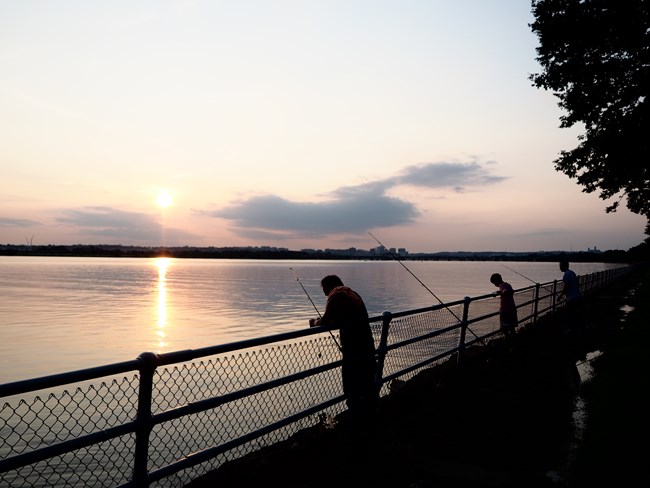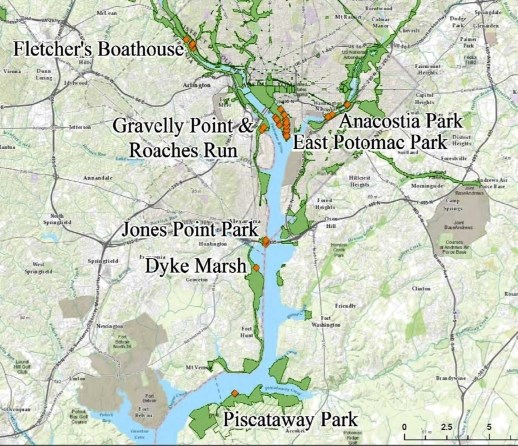Last updated: November 5, 2024
Article
Subsistence Fishing on the Potomac and Anacostia

NPS Photo / S.J. Fiske
This study uses a combination of methods for collecting information, both formal and informal. It documents who is fishing, what they are catching, and how many of the anglers are keeping/eating what they catch. It also provides information gathered from interviews about why these individuals are fishing and why they’re keeping what they catch.
It is important to note that, although fishing and consuming the catch is a common practice along the Potomac and Anacostia Rivers, there are fish consumption regulations in effect in Washington D.C., Virginia, and Maryland. What the study found was that although the Potomac and Anacostia waters are “known to be contaminated…anglers come to fish on the rivers, sometimes driving some distance from their homes and consume their catch despite advisories.”
During the field research for this study, researchers most often encountered anglers at Hains Point, Fletcher’s Cove, Piscataway, Jones Point, C&O Canal, Little Hunting Creek in Virginia, and Fort Washington Light House (on the Maryland side).

NPS

NPS

NPS Photo
“So I had a rod, but it just had a line on it. So I walked up to him [gesturing to the fisherman on his left]–I was gonna buy a hook from him, and a sinker. He said “Man, I got you, man.” He hooked everything up. So… we been having fun ever since. And I met him yesterday! And he brought the children. Yeah, we been laughing since yesterday!” -A fisher at Hains Point
However, there was still a portion of the anglers from this study that do experience some form of food insecurity—about 40%. And while the study did not focus on food insecurity, researchers did find that the extensive sharing of blue catfish, in particular, may provide a substantial buffer to hunger faced by households in the D.C. metro area. Blue catfish are, by a huge margin, fished for most often and harvested in the greatest amounts. Ninety-three percent of the anglers that harvest blue catfish shared at least part of their catch, and blue catfish are shared most broadly (amongst family, friends, acquaintances, and strangers rather than just family and friends).

NPS Photo / Terry Adams
Whether fishing for sport or for food, there is no doubt that parks are high-intensity fishing spots. Subsistence fishers are the most consistent users of park shorelines, especially during the summer, but also during winter months. Being able to go fishing is important to the great majority of anglers and fishing provides a sense of self-reliance for being able to provide for oneself, family, or neighbors in need, and a sense of self-respect garnered from the extensive sharing of their harvests.“Nope, don't even know 'em. Ninety-five [percent] of the time I don't even know 'em. They're like, ‘are you throwing it back in?’ and I'll say ‘not if you want it,’ and they say ‘I'll take it,’ and I'll say ‘okay it's yours.’ It’s everybody…anybody that wants to eat fish.” -A fisher at Jones Point
Opportunities to Fish
For anyone interested in fishing, there are plenty of opportunities in the D.C. metro area to get involved. It is important to note that fishing in D.C. requires a fishing license, and prices vary between residents and non-residents. Annual National Fishing and Boating Week takes place every June, and during this week some states waive the need for a fishing license for a period of time to encourage new anglers to try fishing (check Free Fishing Days before participating). At any other time during the year, National Park Service parks welcome visitors to participate in fishing activities. Check local NPS park websites to learn more about policies on fishing.
About the Report
Fiske S, Callaway D, Cohen A, Walker L, Lopez N. 2020. Ethnographic Resource Study Subsistence Fishing on the Potomac and Anacostia Rivers.Tags
- anacostia park
- chesapeake & ohio canal national historical park
- george washington memorial parkway
- national capital parks-east
- national mall and memorial parks
- piscataway park
- ncr
- cultural resources
- anthropology
- ethnography
- national park service
- nps
- national capital region
- district of columbia
- washington d.c.
- potomac river
- anacostia river
- piscataway
- east potomac park
- anacostia park
- national mall
- nama
- nace
- hains point
- fishing
- subsistence fishing
- catfish
- striper
- striped bass
- bass
